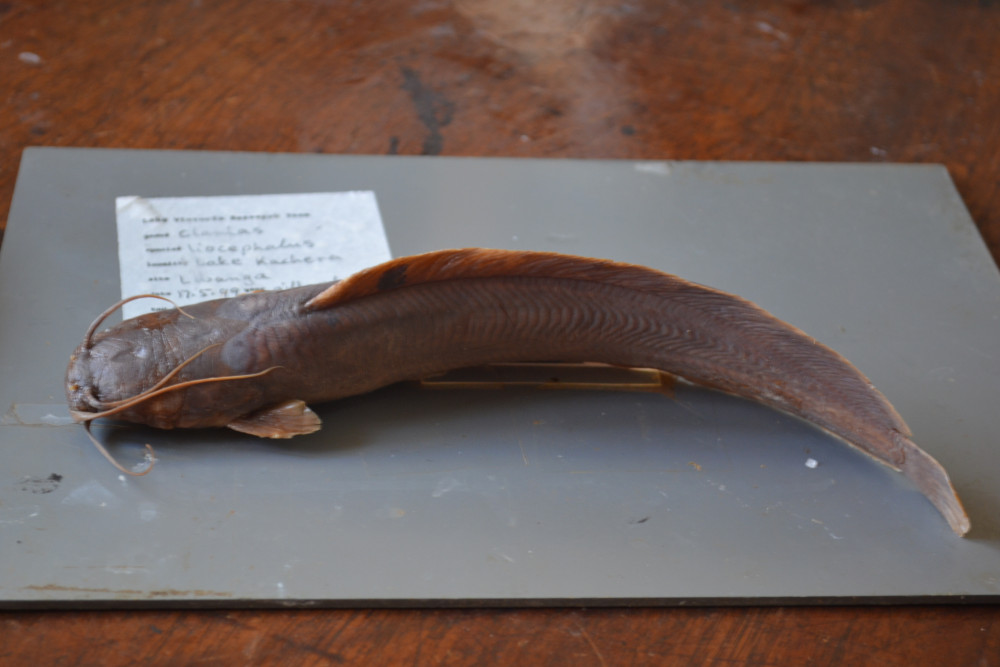Common names:
Smoothhead catfish
Lunyoro/Lukenyi: Nsonzi General name for cat-fishes: Male
Taxonomic tree
Kingdom: Animalia
Phylum: Chordata
Class: Actinopterygii (ray-finned fish)
Order: Siluriformes (Catfishes)
Family: Clariidae (Airbreathing catfishes)
Genus: Clarias
Species: Clarias liocephalus (Boulenger, 1898)
Number of Occurrancies: 163
Etymology(based on Sharpf & Lazara, 2019)
- Clarias: From Greek word chlaros (note that Scopoli’s spelling was Chlarias), meaning lively, referring to the extreme hardiness of clariids and/or their ability to live for a long time out of water (and, in some cases, actually move across land).
- liocephalus: leios, smooth; cephalus, head, referring to smooth head, covered with soft skin.
Synonyms:click here to view synonyms
Type locality: Fwambo, Malawi. Holotype at British Museum of Natural History (BMNH)
Distinguishing characters for the genus
- Flat and broad, usually bony, head (especially on sides behind the eyes); upper surface coarsely granulated in adults and smooth in young fishes (Clariallabes have soft sides of the head)
- Scaleless, elongate, body with small eyes and no adipose fin
- Long dorsal fin, with no spine, extending from slightly behind the head to the caudal fin, from which it is narrowly separated
- Long anal fin, extending to, or almost to the caudal fin base than to the snout
- Air breathing organs derived from the 2nd and 4th epibranchials within the superbranchial chamber (Xenoclarias lack this organ)
- Dorsal and anal fin distinct from the caudal fin (Clariallabes have confluent dorsal, anal and caudal fins)
Distinguishing characters for the species
- Nasal barbels shorter than the head
- maxillary barbels shorter than the head, usually reaching the gill-opening
- Head smooth above, its width contained 1.33-1.25 times in the head length
- Gill rakers course, 10-12 on the first gill arch
- Distance between the tip of the supra-occipital process and the first dorsal ray contained 1.67-2.5 times in head length
- Pelvic fins situated markedly nearer the snout than the origin of the caudal fin, with serrations on the inner and upward directed serrations on the outerside
- The origin of the anl fin lies nearer to the snout than to the caudal fin base
- Color is variable; generally grey-black, lighter below
Distribution in Uganda: Widely distributed across the country's rivers and streams (permanent and temporary). Also present in Lakes Victoria, Kyoga, and Edward.
Occurence: Native
Habitat: Demersal, inhabiting vegetated areas (water-lily and papyrus swamps, and weed-beds) of rivers and lakes.
Feeding: Principally insectivorous, although larger individuals are piscivorous
Biology: The species can grow up to 31 cm, but no information is available on breeding and other life history aspects for Uganda population
Economic importance/End use: local subsistence fishing, mainly for food. It is harvested mainly by baited long lines. The flesh makes good eating and is readily acceptable. Preparation for human food is mainly by boiling, smoking, or deep frying.
IUCN conservation status: Click here to view IUCN status
Threats: Habitat degredation, especially clearence of near-shore wetlands and papyrus where the species feeds and breeds
Main references
- Greenwood PH. 1966. The fishes of Uganda. The Uganda Society, Kampala. 131 pages.
- Sharpf C, Lazara J.K. 2019. Fish Name Etymology Database v12. www.etyfish.org





" thank you for sharing this data with us and allowing us access it freely. "
Aug. 18, 2021, 12:08 p.m." thank you for sharing this data with us and allowing us access it freely. "
Aug. 18, 2021, 12:10 p.m." There is some information on the feeding habits and breeding biology of the species in the Rwizi-rufuha wetland system Southwestern Uganda. "
June 26, 2023, 12:09 p.m.